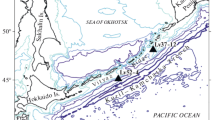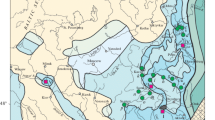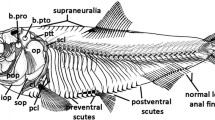Abstract
An analysis of the morphological features of the radiolarian skeletons of the class Stauraxonaria from the Late Carboniferous and Early Permian of the South Urals of Russia and the Western Mugodzhary of Kazakhstan, as well as the Middle Permian of Western Texas in the United States made it possible to reinstate the genus Nazarovispongus Kozur, 1980 and revise the systematic position of the species N. pavlovi and N. permicus established by Kozur (1980). The diagnosis of the reinstated genus Nazarovispongus Kozur, 1980 sensu Kozur et Mostler, 1989, restituo et emend nov. is emended, and the species composition is expanded to include six species: N. pavlovi Kozur, 1980 (type species), N. aequilateralis (Nazarov in Isakova and Nazarov, 1986, comb. nov.), N. delicatus (Nazarov et Ormiston, 1985, part., comb. nov.), N. globosus Nestell et Nestell, 2010, N. inflatus (Nazarov et Ormiston, 1985, comb. nov.), and N. subrotundus (Nazarov in Isakova and Nazarov, 1986, comb. nov.). A new genus Kozurispongus gen. nov. is described, to accommodate six species: K. aktastiensis (Nazarov et Ormiston, 1993, comb. nov.), K. circumfusus (Nazarov et Ormiston, 1985, comb. nov.), K. permicus (Kozur, 1980, comb. nov.), K. semilaminus (Nazarov in Isakova and Nazarov, 1986, part., comb. nov.), and two new species K. concavilatus sp. nov. and K. rotundatus sp. nov. A new scheme of sequential stages of the formation of skeletal spines is proposed.







Similar content being viewed by others
Notes
“Markschale unperforiert, beknotet Oder fein bestachelt, mit drei runden Stacheln, an deren Basis drei groBe Poren sitzen” (Kozur, 1980, p. 237, pl. 2, figs. 1, 2).
“… ein mehrschichtiges spongiöses Aüßenskelett (mit einer feinporigen, nicht immer erhaltenen äußeren Deckschicht und größerem innerem Gewebe) aufweisen (in der Familiendiagnose angeführt). Das ist auch an den REM-Aufnahmen klar zu erkennen” (Kozur, Mostler, 1989, p. 157).
“…shell-shaped, ranging from rounded-triangular to clover-leaf. Shell inflated” (Nazarov, Ormiston, 1985, p. 41).
“Internal sphere porous” (Nazarov and Ormiston, 1985, p. 41).
“Umriß in der Aufsicht gerundet subtriangular mit konvexen Außenseiten. 3 breite, aber kurze tricarinate Stacheln in Dreiecksanordnung sind ausgebildet. Ober- und Unterseite schwach bis mäßig gewölbt. Schalenstruktur spongiös. Größter Teil des Gehäuses zwischen dem Innenskelett und der Außenwand mit spongiösen Gewebe gefüllt, nur die Umgebung der unperforierten Markschale ist frei. Das Innenskelett besteht aus einer subsphärischen, ungegitterten beknoteten Markschale, auf der in Dreiecksanordnung in einer Ebene 3 hohle Kegel aufgesetzt sind, die aus kegelförmig angeordneten, miteinander verschmolzenen Stäben aufgebaut sind und jeweils eine Pore aufweisen. Von den Spitzen dieser Kegel verläuft je ein nadelförmiger Stachel bis zu den 3 Außenstacheln. Vom mittleren und distalen Teil dieser Stacheln zweigen Apophysen ab, die mit dem spongiösen Gewebe verbunden sind” (Kozur, Mostler 1989, p. 205).
A new emended diagnosis of the genus Nazarovispongus was compiled based on the new data of the morphology of the skeleton and taking into account Kozur and Mostler’s (1989, p. 205) diagnosis and the additions to the diagnosis made earlier by Nestell and Nestell (2010, p. 56).
H—maximum height, W—width of the inner cavity, D—diameter of the primary microsphere , L—length of the terminal spike, wL—width of the base of the terminal spike, dp—diameter of the pores of the outer shell, wp—width of the rods of the interpore septum of the outer shell, dc—cell diameter of the cover shell, wc—width of the rods of the intercell septum of the cover shell.
REFERENCES
Afanasieva, M.S., Atlas radiolyariy paleozoya Russkoy platformy (Atlas of Paleozoic Radiolarian of the Russian Platform), Moscow: Nauchnyi mir, 2000.
Afanasieva, M.S., Radiolarian Skeleton: Morphology of Spines, Internal Framework, and Primary Sphere, Paleontol. J., 2007, vol. 41, no. 1, pp. 1–14.
Afanasieva, M.S. and Amon, E.O., Radiolarii (Radiolaria), Moscow: Paleontol. Inst. Ross. Akad. Nauk, 2006.
Afanasieva, M.S., Amon, E.O., Agarkov, Yu.V., and Boltovskoy, D.S., Radiolarians in the geological record, Paleontol. J., 2005, vol. 39, Suppl. 3, pp. 135–392.
Afanasieva, M.S. and Amon, E.O., and Chernykh V.V., Radiolarians of the Asselian-Sakmarian boundary beds (Lower Permian) of the Kondurovka Section (western slope of the South Urals), Byull. Mosk. Obshch. Ispyt. Prir., Otd. Geol., 2014, vol. 89, no. 4, pp. 64–82.
Afanasieva, M.S. and Amon, E.O., and Chernykh V.V., Artinskian (Lower Permian) radiolarians of the Aktasty Reference Section, Northern Mugodzhary, Byull. Mosk. Obshch. Ispyt. Prir., Otd. Geol., 2015, vol. 90, no. 5, pp. 9–27.
Aitchison, J.C., Suzuki, N., and O’Dogherty, L., Inventory of Paleozoic radiolarian species (1880–2016), in Catalogue of Paleozoic radiolarian genera, Danelian, T., Caridroit, M., Noble, P., and Aitchison, J.C., Eds., Geodiversitas, 2017, vol. 39, no. 3, pp. 533–637.
Caridroit M., De Wever P. Some Late Permian radiolarians from Pelitic Rocks of the Tatsuno Formation (Hyogo Prefecture), Southwest Japan, Marine Micropaleontol. 1986. V. 11. P. 55–90.
Dumitrica, P., Systematics of Sphaerellarian radiolarians, in Morphology, ecology and evolution of radiolarians: Mater. IV Symp. European radiolarists EURORAD IV, M.G. Petrushevskaya and S.D. Stepanyants, Eds., Leningrad: Nauka, 1984, pp. 91–102.
Isakova, T.N. and Nazarov, B.B., Late Carboniferous-Early Permian stratigraphy and microfauna of the Southern Urals, Trudy Geol. Inst. Akad. Nauk SSSR, vol. 402, pp. 1–184.
Kozur, H. and Mostler, H., Radiolarien und Schwammskleren aus dem Unterperm des Vorurals, Geol.-Paläontol Mitt. Innsbruck, 1989, Sonderband 2, pp. 147–275.
Kozur, H., Ruzhencevispongidae, eine neue Spumellaria Familie aus dem oberen Kungurian (Leonardian) und Sakmarian des Vorurals, Geol.-Paläontol. Mitt. Innsbruck, 1980, vol.10, no. 6, pp. 235–242.
Nazarov, B.B., Paleozoic radiolarians. Thesis for the degree of Dr. Geol. Min. Sci. Moscow: Geol. Inst. SSSR, 1984.
Nazarov, B.B., Radiolyarii paleozoya. Prakticheskoye rukovodstvo po mikrofaune SSSR. Spravochnik dlya paleontologov i geologov (Paleozoic Radiolaria. A Practical Guide to the Microfauna of the USSR. A Guide for Paleontologists and Geologists), Leningrad: Nedra, 1988, vol. 2.
Nazarov, B.B. and Ormiston, A.R., A new superfamily of stauraxon polycystine Radiolaria from the Late Paleozoic of the Soviet Union and North America, Senckenb. Lethaea, 1983, vol. 64, no. 2/4, pp. 363–379.
Nazarov, B.B. and Ormiston, A.R., Tentative system of Paleozoic Radiolaria, in Morphology, ecology and evolution of radiolarians: Mater. IV Symp. European radiolarists EURORAD IV, M.G. Petrushevskaya and S.D. Stepanyants, Eds., Leningrad: Nauka, 1984, pp. 64–87.
Nazarov, B.B. and Ormiston, A.R., Radiolaria from Late Paleozoic of the Southern Urals, USSR, and West Texas, USA, Micropaleontology, 1985, vol. 31, no. 1, pp. 1–54.
Nazarov, B.B. and Ormiston, A.R., Biostratigraphic potential of Paleozoic radiolarians, in: Radiolyarii v biostratigrafii (Radiolarians in biostratigraphy), Sverdlovsk: Ural. Otd. Akad. Nauk SSSR, 1990, pp. 3–25.
Nazarov, B.B. and Ormiston, A.R. New biostratigraphically important Paleozoic Radiolaria of Eurasia and North America, Radiolaria of giant and subgiant fields in Asia, Micropaleontology Spec. Publ., 1993, no. 6, pp. 22–60.
Nestell, G.P. and Nestell, M.K., Late Capitanian (latest Guadalupian, Middle Permian) radiolarians from the Apache Mountains, West Texas, Micropaleontology, 2010, vol. 56, no. 1–2, pp. 7–68.
Noble, P., Aitchison, J.C., Danelian, T., et al., Taxonomy of Paleozoic radiolarian genera, in Catalogue of Paleozoic radiolarian genera, Danelian, T., Caridroit, M., Noble, P., and Aitchison, J.C., Eds., Geodiversitas, 2017, vol. 39, no. 3, pp. 419–502.
Oudemans, A.C., Neues über Anystidae (Acari), Archiv für Naturges, N.S., 1936, vol. 5, pp. 364–446.
Özdikmen, H., Substitute names for some unicellular animal taxa (Protozoa), Munis Entomol. and Zool., 2009., vol. 4, no. 1, pp. 233–256.
Won, M.-Z. Radiolarien aus dem Unter-Karbon des Rheinischen Schiefergebirges (Deutschland), Palaeontogr. Abt. A., 1983, vol. 182, nos. 4–6, pp. 116–175.
ACKNOWLEDGMENTS
The author is grateful to A.S. Alekseev, V.S. Vishnevskaya and G.P. Nestell for valuable advice and constructive comments; A.F. Bannikov, Ya.M. Kuzmina and M.A. Knorre for help in preparing the manuscript for publication; and to S.V. Nikolaeva for translating this paper into English.
Photographs of radiolarians from Kozur (1980) and Nestell and Nestell (2010) are copyright of “©Universität Innsbruck, Institut für Geologie” and “©Micropaleontology” and used with the kind permission of Prof. Diethard Sanders (Sanders) and Dr. Mike Kaminski.
Funding
This work was carried out within the framework of the program (state assignment) of the PIN RAS and with the support of the program of the Presidium of the Russian Academy of Sciences “Evolution of the organic world. The role and influence of planetary processes.”
Author information
Authors and Affiliations
Corresponding author
Additional information
Translated by S. Nikolaeva
Rights and permissions
About this article
Cite this article
Afanasieva, M.S. Radiolarians of the Class Stauraxonaria from the Late Carboniferous–Middle Permian: Nazarovispongus Kozur sensu Kozur et Mostler, restituo et emend. nov. and a New Genus Kozurispongus gen. nov.. Paleontol. J. 55, 244–258 (2021). https://doi.org/10.1134/S0031030121030023
Received:
Revised:
Accepted:
Published:
Issue Date:
DOI: https://doi.org/10.1134/S0031030121030023




